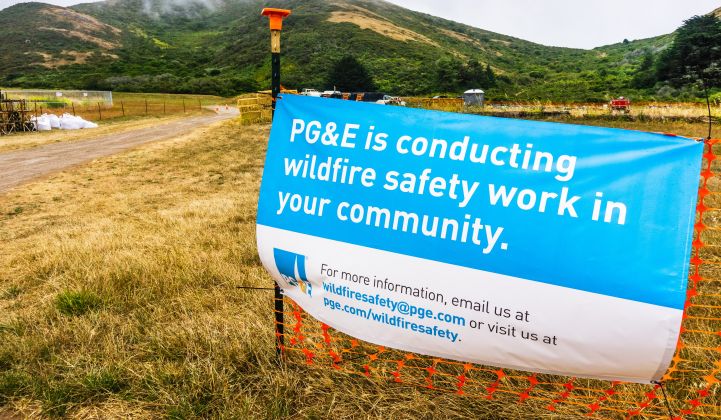California Gov. Gavin Newsom’s late Friday decision to reject Pacific Gas & Electric’s bankruptcy reorganization plan has left the state’s largest utility scrambling to craft a new one that can win his approval.
PG&E had until Tuesday to respond to Newsom's critiques with an amended plan, under the utility's own commitment to get the governor's approval prior to submitting the plan to bankruptcy court.
While PG&E’s final fate remains in the hands of bankruptcy court, Newsom’s political support could be crucial for it to emerge from bankruptcy by a June 2020 deadline.
UPDATE: PG&E on Monday removed this deadline from the conditions of its $13.5 billion settlement with wildfire victims, and on Tuesday received approval of that settlement, and another $11 billion settlement with insurance claims holders, from U.S. Bankruptcy Judge Dennis Montali, who is overseeing its case.
In the meantime, PG&E shareholders, creditors and counterparties spent the weekend parsing Newsom’s rejection letter, trying to discern which demands can reasonably be met — and which may be dealbreakers.
The biggest roadblock
The biggest challenge for PG&E’s existing management and investors backing the plan, as opposed to a rival plan from bondholders seeking to take control of the company, will be Newsom’s demand that it reduce its reliance on debt financing, analysts agree.
In order to meet its settlement with wildfire victims, insurers and county and local governments, keep its clean energy commitments and satisfy other creditors, PG&E has relied on a “combination of holdco debt, secured debt, securitization and monetization of the net operating losses in order to make plan distributions,” Newsom wrote. But this approach could leave PG&E with “limited tools to finance itself” in the event of an unforeseen crisis, leaving its much-needed multibillion-dollar grid and safety investments in jeopardy.
It could also force PG&E to rely on the $21 billion wildfire fund created by state law AB 1054 this summer to cover its staggering liabilities. This fund is meant to protect fellow investor-owned utilities Southern California Edison and San Diego Gas & Electric from the threat of credit downgrades in the face of otherwise massive potential future liabilities for catastrophic fires under the state’s inverse condemnation legal doctrine — not to bail out PG&E.
As Jared Ellias, a law professor at UC Hastings, wrote on Twitter, PG&E’s plan is “only remotely feasible” because of the plan’s insurance backstop. Many of the plan's key aspects, such as PG&E's promise to keep honoring its renewable energy contracts and other state environmental goals, have been forced upon it.
“If you follow the design of AB 1054[,] it would seem to point towards this bankruptcy outcome,” Ellias wrote.
A rival reorganization plan from PG&E bondholders is less reliant upon debt, and it “provides more headroom for making investments in safety that Newsom has highlighted as critical when the company reemerges from Chapter 11,” Rob Rains, analysts with Washington Analysis, wrote in a Monday note.
That distinction could give the bondholder group, which includes Elliott Management Corp. and Pacific Investment Management Co., a step up in its goal to take majority control of PG&E.
Potential time bomb
Another key stumbling block for PG&E comes in the form of Newsom’s demand for an “escalating enforcement process” to hold it to account for future safety failures or broken promises. As described in Friday’s letter, this would include “a streamlined process for transferring the company’s license and operating assets to the state or a third party when circumstances warrant.”
Support for a public takeover of PG&E has been rising in the face of the utility’s safety failures, with this autumn's massive and poorly executed fire-prevention power outages driving dozens of municipalities to call for PG&E’s assets to be transferred to public ownership. This public pressure has “likely inspired this provision” in Newsom’s letter, Rains noted.
But it would also be an unprecedented process that could take years of legal wrangling over fair market value, eminent domain and other key issues. "Therefore, this would not be a quick fix," Rains said.
In the meantime, this demand is a potential time bomb for would-be investors in a post-bankruptcy PG&E. As Ellias tweeted, “Is Wall Street interested in investing in a utility with a ‘self-destruct button’ instead of the flexibility that Chapter 11 provides?”
It’s also not clear how such an agreement could override standing bankruptcy law, he contended. “Wouldn’t PG&E just file for bankruptcy anyway and try to renegotiate?”
The low-hanging fruit
Some of Newsom’s demands will be much easier to meet. For example, replacing the current board of directors, chosen for their bankruptcy reorganization expertise, with a slate of mostly California residents and “members with extensive safety experience,” is likely something PG&E was preparing to do anyway.
Similarly, Newsom’s demand for “strict, clearly defined operational and safety metrics” is already a top area of focus of the California Public Utilities Commission, which is reviewing PG&E’s fire safety plan and investigating the flawed fire-prevention power outages that it conducted this autumn.




